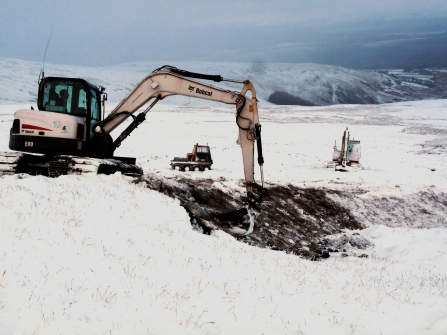A new report from the Office on National Statistics published this week is highlighting the importance of conserving our peatlands in reducing the UK’s CO2 emissions, a key factor in the fight against climate change.
The report states: ‘We estimated restoration cost accounts for the UK’s peatlands. In the absence of a comprehensive plan to achieve this in the UK we initially used a blunt set of assumptions with the intent of highlighting the trade-offs involved and providing a conservative estimate of cost. The costs of restoring 100% of peatlands could be significant at between £8 billion and £22 billion but these are approximately one-tenth to one-fifth of the carbon emissions benefits that would be gained. More conservative estimates of the benefits of meeting the committee on climate change objective of having 55% of peatland in good status were of the order of £45 billion to £51 billion over the next 100 years.’
Neil Harnott, Senior Conservation Manager, at Cumbria Wildlife Trust says:
“Our upland peatlands are vital in providing society a whole host of benefits, not least the vital role they could play in helping combat climate change. The Office of National Statistics report is yet another report that shows how investing money in restoring these habitats leads to cost savings not only in combating climate change, but in reducing water pollution and protecting downstream communities from flooding.
“It is vital that the new subsidy regime prioritises the restoration and protection of these vital habitats for the benefit of local communities, society at large and the wealth of wildlife that they support.”
Cumbria Wildlife Trust is currently working on a number of peatland projects in Cumbria such as Bampton Common, above Haweswater, and has a large number of degraded peatlands awaiting funding.
Stephen Trotter, the Trust’s Chief Executive, added: “Since 2011, we’ve delivered restoration on nearly 3000 ha. of moorland bogs. Working with farmers, landowners, commoners and local contractors, we’ve calculated that over the last five years these restoration projects have saved 2949.95 tonnes of CO2 equivalent every year; that is carbon which is no longer being released into the atmosphere. This is a massive saving every year equivalent to taking 1640 cars off the roads each and every year – or 8,200 over the last 5 years.”
Stephen said: “We’re extremely grateful to the Government, Environment Agency, Natural England, United Utilities and the many other funders who have made this vital restoration work possible through nearly £1M of investment. However, there is so much more to be done – and sadly there are still many outstanding sites in a poor state. We urgently need further funding to stop further carbon loss and water pollution – not to mention bringing back the many rare plants and animals which rely on these special and valuable bogs.”
“Putting Cumbria’s bogs back into good health is a good value investment for everyone – farmers, wildlife enthusiasts, government and the general public will all benefit”.
What are peatlands?
Peatlands are very unique habitats that are more commonly known as ‘bogs’, however this term does not capture the diversity of peatlands and there are actually many different types of habitat that fall under the heading of peatlands including blanket bog, lowland raised mire and valley mire.
Why does peatland restoration matter?
Cumbria Wildlife Trust's survey of bogs in the Lake District confirmed that most have been damaged, prompting action to restore peatland. At least 70 per cent of English peatlands are damaged by drainage, heavy grazing, regular burning, cultivation, forestry or other management. Scotland and Wales appear similar.
Once the peatland is damaged it is no longer waterlogged and the specialist plant species that make the peatland, such as Sphagnum mosses, cannot survive.
Once these plant species are lost bare peat areas can form and the surface dries, crumbles and cracks; rapidly eroding during severe weather.
Restoring peatlands aims to reverse this damage by covering bare peat areas with vegetation, blocking drains to raise the water table and return the waterlogged conditions and re-introducing Sphagnum mosses into areas they have been lost.
The full report can be found here https://www.ons.gov.uk/economy/environmentalaccounts/bulletins/uknaturalcapitalforpeatlands/naturalcapitalaccounts
More information about conserving peatlands can be found here https://www.cumbriawildlifetrust.org.uk/about/what-we-do/living-landscapes/wildlife-conservation-projects/peatland-restoration

